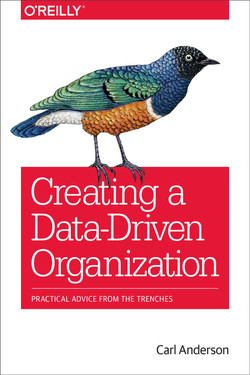- Tags:: 📚Books , Working in Data
- Author:: Carl Anderson
- Liked:: 6
- Link:: Creating a Data-Driven Organization
- Source date:: 2015-08-01
- Finished date:: 2023-11-01
- Cover::

Why did I want to read it?
Hay que leer libros de estos de vez en cuando, que hacen un poco de auto-ayuda.
What did I get out of it?
Preface
Many organizations think that simply because they generate a lot of reports or have many dashboards, they are data-driven (…) they are often a declaration of past or present facts without a great deal of context, without causal explanation of why something has or has not happened, and without recommendations of what to do next. In short, they state what happened but they are not prescriptive. As such, they have limited upside. In contrast, consider more forward-looking analyses, such as predictive models that optimize ad spend, supply chain replenishment, or minimize customer churn. (p. viii)
…insights require collecting the right data, that the data is trustworthy, the analysis is good, that the insights are considered in the decision, and that they drive concrete actions so the potential can be realized (…) the analytics value chain. (p. viii)
Also from the bottom to the top:
[the guys closest to the data] they can help educate the rest of the organization to be more data literate. Part of that comes from developing their skill set and using it to do good work. Another part, however, comes from being more business savvy—learning the right questions to ask and business problems to tackle—and then “selling” their insights and recommendations to the decision-makers (p. viii)
1. What do we mean by data-driven?
The definition:
Data-drivenness is about building tools, abilities, and, most crucially, a culture that acts on data (p. 1)
The problem is if this are all the same people! (likely not, that’s one difficulty, see Data team roles):
for an organization to be data-driven, there have to be humans in the loop, humans who ask the right questions of the data, humans who have the skills to extract the right data and metrics, and humans who use that data to inform next steps. (p. 4)
From reporting and alerting to analysis.
Reporting especially is a highly valuable component of a data-driven organization. You can’t have an effective one without it. However, the reverse is not true: there are many organizations that focus on reporting and may have little to no real (objective) analysis. (p. 7)

Careful with Forecasting:
(C is a danger zone: it can be easy enough to extend a perceived trend out to the future—in Excel, click “Chart” and then “Add trend‐ line”—that is, extrapolate outside the current’s data range and make a naïve prediction. Even making a sensible choice about a functional form for the model, there are many reasons why that prediction may be misleading or plain wrong. To have confidence in those predictions, you should strive to have a causal model. (p. 9)

Ron Shevlin makes some great points: From a capabilities perspective, there’s no reason why a firm couldn’t forecast something likes sales (“level” 6) without knowing where exactly the “problem” with sales is (“level” 3)…How could I, as a manager, address the question of “what actions are needed now?” without some understanding of “what if these trends continue?” and “what will happen next?” (“levels” 6 and 7)? (p. 14)
In a fascinating study, MIT Sloan Management Review collaborated with IBM Institute for Business Value to survey 3,000 managers and analysts across 30 industries about their use of and beliefs about the value of analytics. (LaValle, S., M. S. Hopkins, E. Lesser, R. Shockley, N. Kruschwitz, “Analytics: The New Path to Value.” MIT Sloan Management Review, October 24, 2010.).
Interestingly, compared to lower per‐ formers, top performers were: • Five times more likely to use analytics
• Three times more likely to be sophisticated analytics users
• Two times more likely to use analytics to guide day-to-day operations
• Two times more likely to use analytics to guide future strategies (…)
- 63% more likely to use a centralized analytics unit as the primary source of analytics (p. 16)
Other notes
From W. Edwards Deming: Without data you’re just another person with an opinion (p. 1)
Which strategies have proved successful in promoting a data-driven culture in your organization? (p. 206)

